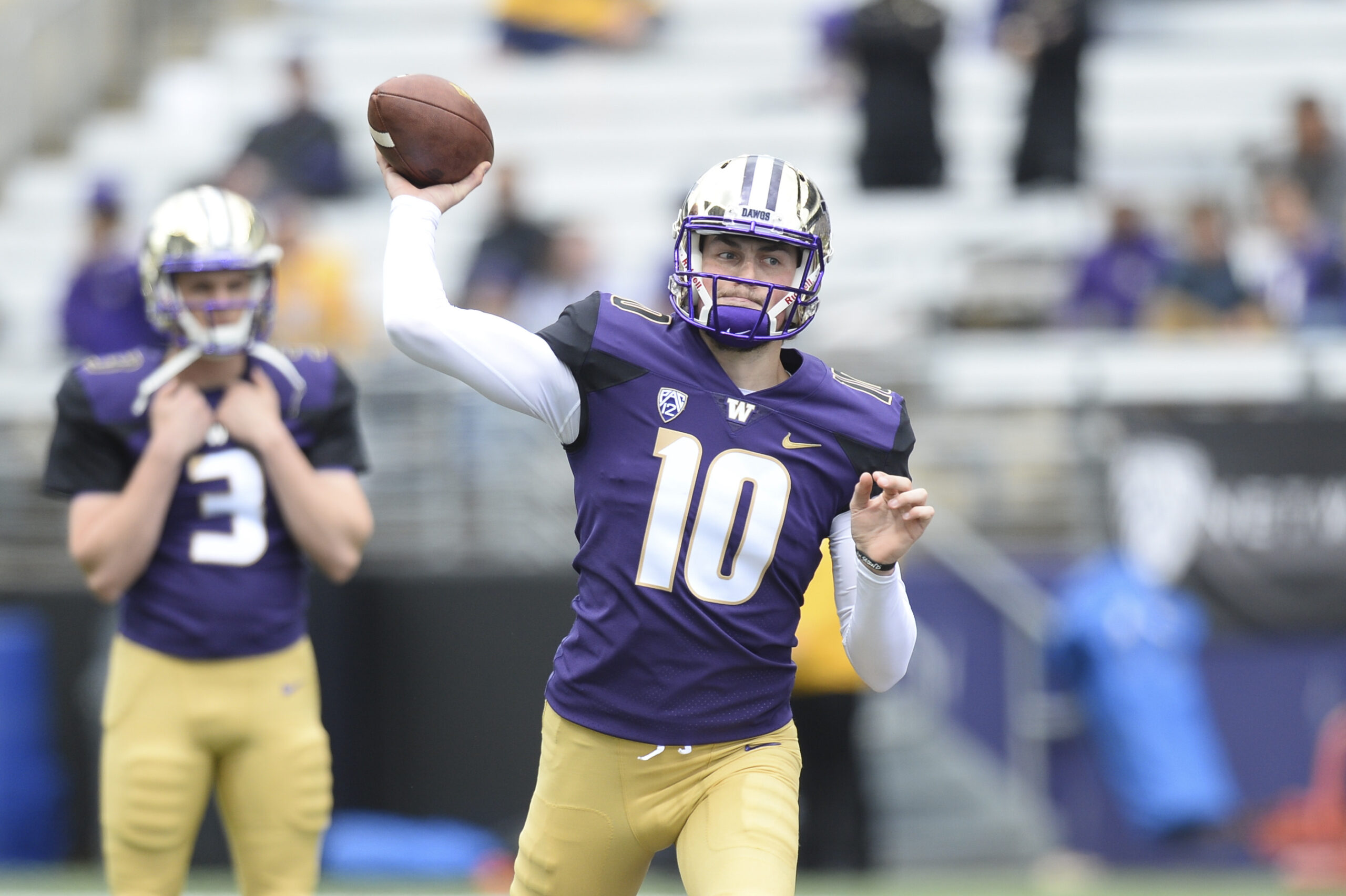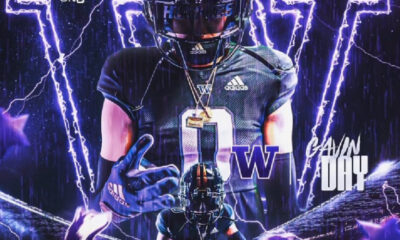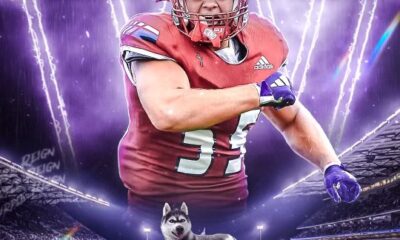Jacob Eason is the favorite to take the reigns of the Washington offense in 2019 and he’s been labeled everything from a future NFL first-round pick to someone who couldn’t hack it in the SEC. When it’s all said and done, what will Jacob Eason’s legacy at Washington be?
It was February 6th last year when Eason officially announced he was transferring to the University of Washington. Now with spring ball right around the corner, he’s potentially a weeks away from potentially claiming the position for good.
Washington’s Last Five Star QB
Eason will be the first modern-day five star recruit to play quarterback for Washington. Matt Tuiasosopo was a 5 star QB in some rankings when he graduated from Woodinville HS in 2004 but while he signed with Washington, he never stepped foot on campus instead electing to play baseball in the Seattle Mariners farm system. (And they haven’t made the playoffs since, coincidence?) Would the Huskies have fallen as far as they did in the 2000’s had Tuiasosopo stepped in and followed in his brother’s footsteps? It’s fun to speculate.
Before they became Jimmy Lake’s DB-U, Washington was TE-U and in their own right a bit of a QB-U with several stand-outs in the 70’s, 80’s and 90’s. Every senior starter at Washington from Warren Moon in 1979 to Cody Pickett in 2002 would start at least a game in the NFL.
Since then the Huskies have had a long line of good but not spectacular quarterbacks. Jake Locker was a 1st round pick but due to his issues with injuries and accuracy he never made a 1st or 2nd team All Pac-10 team.
Keith Price and Browning both had record-breaking sophomore seasons with an array of weapons but once those players graduated they struggled to get back to an elite level. Other quarterbacks Casey Paus (42 unanswered against Oregon in 2002), Isaiah Stanback (4-1 start in 2006) and Cyler Miles (Rallying a 5 loss team to a bowl game) had their moments but never had sustained success.
Washington and Transfer QB’s
Eason is not the first Puget Sound area kid to leave the area initially only to end up on Montlake. The most notable being Johnny DuRocher, a 4 star QB who signed with the Ducks in 2002 after he graduated from Bethel High School. DuRocher redshirted in 2003 and then left early during the 2004 season citing philosophical differences with then coach Mike Belotti. The reality was that DuRocher was one of three HS QB’s the Ducks signed in their 2003 class and Dennis Dixon was a superior player.
DuRocher played two seasons for Washington completing just 29 of his 71 passes (41%) with 3 touchdowns and 4 interceptions before retiring when a brain tumor was discovered during a ct scan.
There was Taylor Barton who in 2002 followed Rick Neuheisel from Colorado via junior college and Carl Bonnell who signed with Washington State but never officially enrolled as a greyshirt. They each served as backups their respective senior years.
Eason’s Path to Georgia
Eason’s was a stand out at Lake Stevens starting three years and and throwing over 100 touchdowns in his career. He committed to Georgia the summer of his junior year although he could have gone anywhere in the country.
Eason was following a long line of successful Georgia QB’s. In the 2000’s DJ Shockley and David Greene led the Bulldogs to SEC Championships, Matthew Stafford was the NFL’s #1 overall pick in 2005 and Aaron Murray set just about every SEC career passing record there is.
By the time Eason got to campus the Bulldogs were in transition. Mark Richt had developed a reputation for consistently winning 9 to 10 games a year but his last major bowl win was about eight years in the rear view mirror and Georgia decided to move on. They hired Kirby Smart who had been serving as the defensive coordinator for Nick Saban at Alabama. Deke Wiggins has been following Georgia 39 years and operates the Georgia site TheDawgBone, he recalls Georgia holding off a push from Florida once Richt was dismissed.
“There was some concern when Mike Bobo (Eason’s recruiter) got hired at Colorado State,” Wiggins said. “But Kirby made it a priority to get up to (Washington) and make sure he stayed with Georgia and Eason never seemed to waver from that.”
Eason graduated early so he could attend spring ball. The Bulldogs had a returning starter in 5th year senior Greyson Lambert, a kid who grew up in Georgia but played his first three years for Bronco Mendenhall at the University of Virginia. Because Lambert qualified as a graduate transfer, he had immediate eligibility and 2 years to play 2.
In 2015 Lambert led the team to a 10-3 record and completed 63% of his passes throwing for 1959 yards in 12 games. Lambert threw 12 touchdown passes and was only intercepted twice. While Lambert proved good at “not losing” games, there was an excitement that Eason would be able to win games single-handedly with his arm.
“Eason’s a cautious passer,” Wiggins explained. “Lambert was to a fault.”
Eason actually started the 2016 season as Lambert’s backup. The Bulldogs first game was the same Chick-Fil-A Classic the Huskies played in last year against Auburn. Georgia was in the top 25 and facing #22 North Carolina with the Tar Heels starting Mitchell Trubisky at QB, a man who would be the #2 overall pick that spring. Lambert started the game but struggled before giving way to Eason.
Greg Poole is the multimedia director for the credentialed Georgia website BulldawgIllustrated and remembers Eason breathing life into the team that night.
“I was on the sideline and heard the cheers,” Poole said. “When Eason came in, you could tell the fan base was excited to see him.”
Eason would throw for 131 yards and a touchdown, Lambert had just 54.The Bulldogs won the game 33-24 and Eason would take over the starting job that following week.
“Everyone knew it was only a matter of time,” Wiggins explained.
At the time Bulldogs had two dynamic backs in Nick Chubb and Sony Michel. Their names may sound familiar because they both play on Sundays with Michel scoring the only touchdown in the Super Bowl two weeks ago.
In 2016 Chubb was coming back from a gruesome injury that had some wondering if he would ever be the same player. He had already ran for over 2,000 yards, rushed for 7.1 ypc as a freshman and 8.1 as a sophomore but his yards per carry dropped to 5.0 as a junior as Georgia’s offensive line took steps backwards. Georgia actually finished just 50th in the nation in rushing Eason’s freshman year.
“I don’t think either of those guys (Chubb or Michel) was ever 100 percent that year,” Wiggins said noting Michel suffered a serious elbow injury his freshman year.
“Smart inherited an offensive line that had been under recruited by Richt for many years,” Pool said” When you look at (Eason’s) numbers, the offensive line wasn’t nearly as good as he was.”
After a game against Nicholls State that was closer than it should have been, Eason had his coming out moment. With his team down six and under two minutes left on the road against Missouri he threw a 4th and 10 seam route on a rope and a PAT later, Georgia had a 28-27 lead they would hold on to.
Georgia was blown out in their next game by Ole Miss but that following week against Tennessee Eason was closing in on another signature win.
Had it not been for Tennessee’s miracle Georgia would have been 4-1 but instead lost 3 of 4 to fall to .500. The Bulldogs finished 7-5 in the regular season before beating TCU 31-23 in the Liberty Bowl.
Eason finished his freshman season completing 55% of his passes with 16 touchdowns. He only threw 8 interceptions which isn’t bad for a true freshman in a conference known for superior defense.
“He can be cautious, there were times he would hold on to it and maybe get sacked but to be fair I don’t think there were guys getting separation at receiver.” Wiggins said.
That winter Georgia signed another 5 star, getting Fromm to decommit from Alabama and play in Athens. Even so Eason went into his sophomore season the starter.
In part two we’ll take a closer look at Eason’s injury, his sophomore season and how he could fit into the Washington offense this spring.











